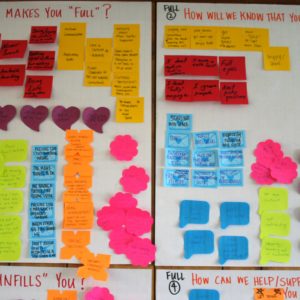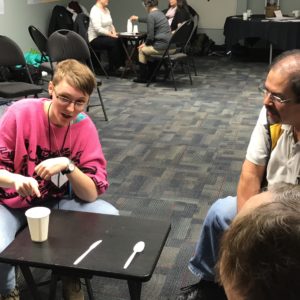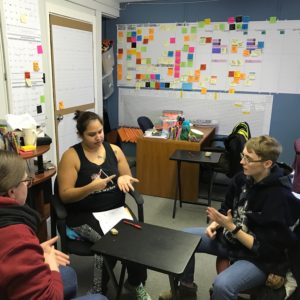In addition to fall and spring conferences, every year, the Maryland Foreign Language Association travels to a different region of the state, to bring professional development directly the language teachers in those areas. This year I had the opportunity to work with teachers on Maryland’s eastern shore, and share with them some of the core Where Are Your Keys? techniques.
A popular buzz-term in formal education these days is “student-centered learning,” which has been the primary focus of my school’s professional development this year. In the past, I’ve heard this idea expressed as teachers being the “guide on the side, rather than the sage on the stage.”
The introduction to “Student-centered learning” on Wikipedia says:
Student-centered learning, also known as learner-centered education, broadly encompasses methods of teaching that shift the focus of instruction from the teacher to the student. In original usage, student-centered learning aims to develop learner autonomy and independence by putting responsibility for the learning path in the hands of students. Student-centered instruction focuses on skills and practices that enable lifelong learning and independent problem-solving.
Anyone who’s had even a little exposure to Where Are Your Keys? can recognize it as among the most complete examples of this learning model.
As we discussed at the 2014 Pedagogy Rusticatio, WAYK offers some exciting tools for the classroom teacher, but also has to navigate constraints that might not be found in other community-based language learning environments. For many teachers new to WAYK, the biggest challenge is not implementation, but mind-set and philosophy. For our one-hour session together, I wanted teachers to leave not only with strategies for their classrooms, but a new way of looking at their instruction.
I framed WAYK’s main TQ‘s into three key concepts:
- Students control the learning environment
- Students teach one-another
- Students drive the curriculum
In such a short time, we could realistically only address the first two points, but I wanted teachers to be aware of the long-term goal of student-centered learning, using WAYK.
Students control the learning environment
This idea includes most of the first TQ’s people learn when they are introduced to WAYK. We often refer to them as the “stereo-controls” (have no doubt, today’s students have no idea what a stereo is): Slow Down/Speed Up, Again, Three Times, Louder, etc. While these introductory (and minimally “meta”) TQs may seem basic, perhaps even trivial, their implications for the classroom and learning are profound. When a student throws Slow Down and is met with an appropriate response from their teacher, they have gained agency in their learning. This is in stark contrast to the way most classroom students have been taught to think about education (i.e. teachers teach and students learn, in a strict one-way hierarchy). In my own classes, I make students explicitly aware of this difference and challenge them to test the boundaries of their perceived role in learning.
Students teach one-another
Being Angels and part of a Bucket Brigade eases students into their role as teachers. Many teachers at first are nervous about what they imagine to be chaos in the classroom. While at first glance a student centered classroom may seem chaotic (it doesn’t remotely resemble the traditional model where “teaching” is easy to recognize) a careful observer will see students who are highly engaged and enthusiastic, and a teacher who is free not only to provide individual attention to students most in need, but to encourage and push students at every level.
In my classroom I have implemented two rules:
- I will only teach something once. After that, students will be directed to ask a classmate.
- When a student learns something new, they have to teach at least two classmates.
Stating these rules explicitly, and periodically reinforcing them, helps students to rethink their expectations for learning.
Students drive the curriculum
This last concept is perhaps the most difficult to envision in a traditional classroom setting, where teachers are given prescribed curricula and district-wide learning objectives. However, as language clasrooms continue to move towards proficiency and task-based instruction and assessment, rather than content/theme-based frameworks, there will be increased latitude for students to self-select what topics they would like to explore (in fact it will be a necessity). Things like verb charts and vocabulary quizzes will become out of place in this model, where students automatically acquire the structures most necessary for their own communication.
These distinctions and transitions can be daunting to some teachers, but the payoff is well worth the time it takes to implement these methods faithfully.
Post authored by Jason.





